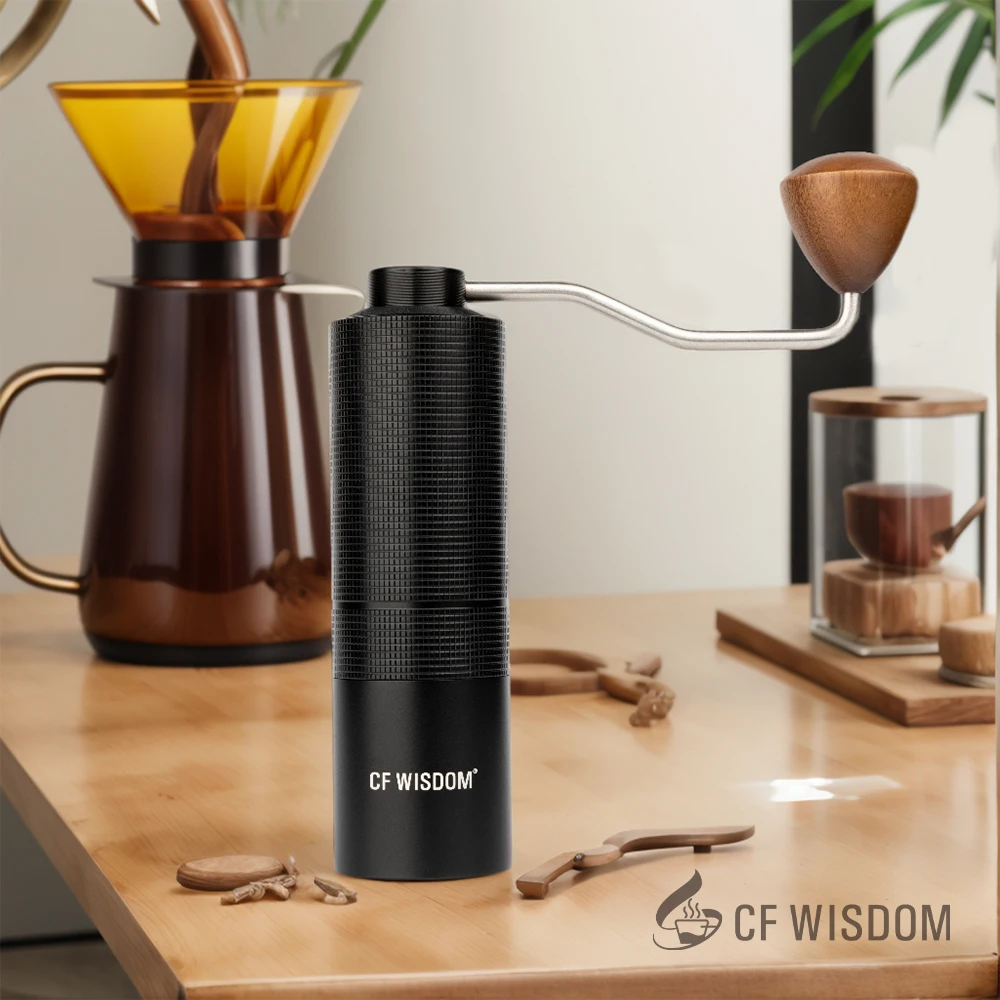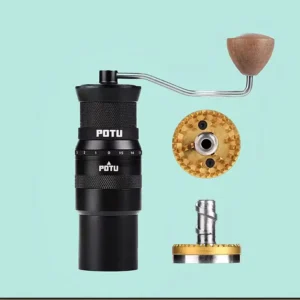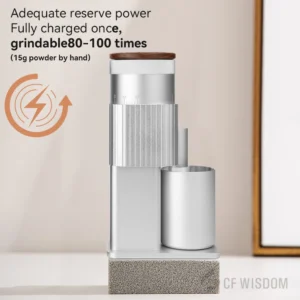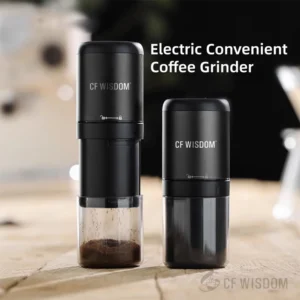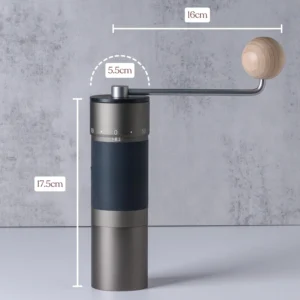Why Grind Size is the Foundation of Exceptional Espresso
The perfect espresso shot begins long before you press the brew button. At its heart lies a critical element that many overlook: the grind size of your coffee beans.
When water passes through ground coffee under pressure, the size of those coffee particles directly determines how the extraction unfolds. Think of it as the gatekeeper that controls how quickly water flows through your coffee, how much pressure builds up, and ultimately, how much flavor is extracted from the beans.
The science behind this is fascinating – grinding coffee beans creates more surface area for water contact. Finer grounds mean more surface area, which allows water to extract flavors more efficiently. This relationship between grind size and extraction is non-negotiable in espresso preparation:
- Too coarse: Water rushes through too quickly, resulting in under-extraction and sour, weak espresso
- Too fine: Water struggles to pass through, causing over-extraction and bitter, harsh flavors
- Just right: Water flows at the ideal rate, extracting a balanced range of flavors
Research consistently shows that extraction yield (the percentage of coffee solids dissolved in water) varies dramatically based on grind size. The difference of just one grind setting can shift extraction by several percentage points, completely transforming your espresso experience.
Understanding precision grind settings forms the foundation upon which all other espresso variables rest. Without this fundamental skill, even the finest beans and most expensive machines will produce mediocre results. Mastering grind size is your first step toward espresso excellence.
Understanding Espresso Grind: Visual Characteristics and Standards
So what exactly should the perfect espresso grind look like? When you’re aiming for that ideal extraction, visual identification becomes a valuable skill.
The ideal espresso grind resembles fine sand or powdered sugar – significantly finer than table salt but not as fine as flour or powdered sugar. When rubbed between your fingers, it should feel slightly gritty but not harsh or coarse. In technical terms, espresso grind typically measures between 180-380 microns in particle size.
This specific range creates the ideal resistance for pressure-brewed espresso. For comparison:
- French press grind: Coarse, like sea salt (1000+ microns)
- Pour-over grind: Medium, like regular sand (500-700 microns)
- Espresso grind: Fine, like powdered sugar or fine sand (180-380 microns)
- Turkish coffee: Extra-fine, like flour (100 microns or less)
Beyond size alone, particle uniformity is equally crucial. Inconsistent grinding creates a mix of fine and coarse particles, leading to uneven extraction where some particles over-extract (bitter) while others under-extract (sour). This results in an unbalanced, often disappointing espresso.
A properly ground espresso dose should also have a certain cohesiveness – if you pinch some grounds together, they should briefly stick together before falling apart. This indicates the right fineness level for proper extraction.
For more detailed visual references, our comprehensive espresso grind size chart provides clear comparisons to help you identify the perfect consistency for your brewing needs.
Essential Equipment for Precise Grinding
Achieving consistent, properly-sized coffee grounds for espresso requires specialized equipment – not just any coffee grinder will do. Understanding your equipment options is essential for espresso success.
Burr grinders are non-negotiable for espresso preparation. Unlike blade grinders that chop beans into inconsistent pieces, burr grinders crush beans between two abrasive surfaces, producing uniform particles. This uniformity is absolutely essential for even extraction.
When selecting a burr grinder, you’ll encounter two main designs:
- Flat Burrs: Two parallel rings that grind coffee between them, often producing very consistent particle size with excellent clarity of flavor
- Conical Burrs: A cone-shaped burr fits inside a circular burr, creating a more efficient grinding path and often retaining less coffee between uses
The difference between these flat versus conical burr manual grinders impacts everything from grind consistency to heat generation during grinding, with each offering distinct advantages for different brewing styles.
Beyond burr type, adjustment mechanism significantly affects your espresso experience:
- Stepped Adjustment: Preset notches or clicks between grind settings, providing easy repeatability but limited fine-tuning
- Stepless Adjustment: Infinite adjustability between coarsest and finest settings, allowing the precise calibration necessary for espresso
For serious espresso preparation, look for grinders with these essential features:
– Fine adjustment capability with enough range for espresso
– Consistent particle size distribution
– Low retention (grounds remaining in the grinder)
– Minimal static build-up
– Durable burrs that maintain sharpness
Remember that grinder quality directly impacts extraction quality. While entry-level burr grinders may suffice for beginning espresso enthusiasts, advanced preparation often requires more precise equipment capable of the micro-adjustments necessary for perfect extraction.
The Step-by-Step Dialing In Process: Finding Your Perfect Setting
“Dialing in” is the systematic process of finding the optimal grind setting for a specific coffee bean on your specific equipment. This process is iterative rather than immediate – expect to make several adjustments before reaching perfection.
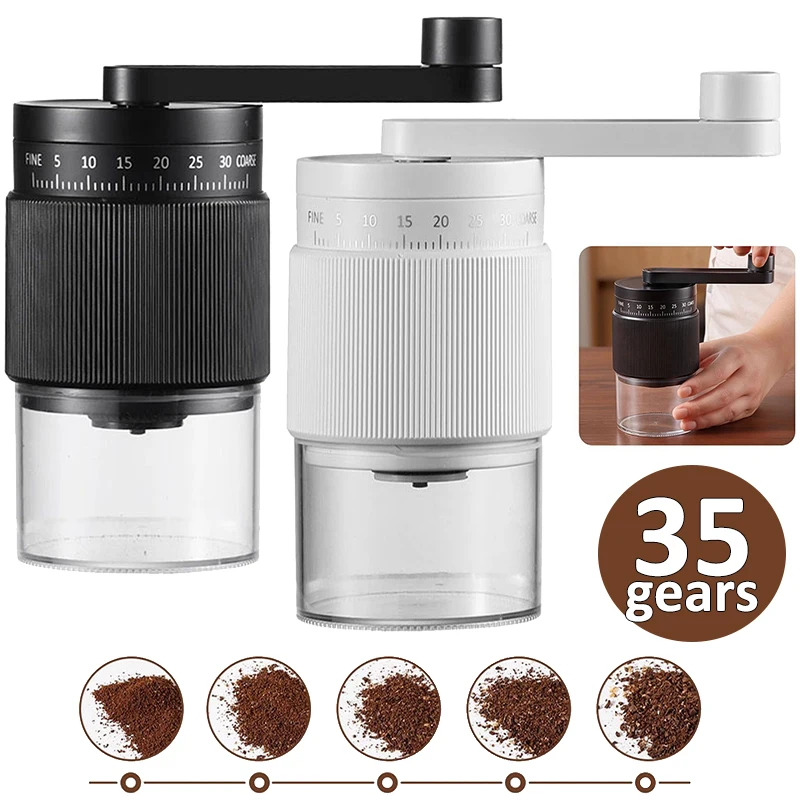
Here’s a methodical approach to dialing in your espresso:
Start with a baseline setting: Begin with your grinder at its recommended espresso setting, or slightly finer than table salt if no recommendation exists.
Prepare your dose: For a standard double shot, weigh 18g of coffee (adjust based on your basket size). Consistency in dosing is crucial during the dialing-in process.
Distribute and tamp: Ensure even distribution in the portafilter and apply firm, level pressure (about 30 pounds) when tamping.
Pull a shot and time it: Aim for a 1:2 ratio (18g coffee to 36g espresso) extracted in 25-30 seconds. Start timing from the moment you activate the pump.
Assess the flow: The espresso should flow like warm honey – a steady stream with the consistency of flowing honey or “a mouse’s tail.”
Taste and evaluate: The ultimate test is taste. Note whether the shot is:
– Sour, thin, watery, or extracts too quickly (needs a finer grind)
– Bitter, harsh, or extremely slow to extract (needs a coarser grind)
– Balanced, sweet, with appropriate acidity and body (you’ve found the right setting)Make adjustments: Change only one variable at a time. If adjustment is needed:
– Extraction too fast/sour taste? Make the grind finer
– Extraction too slow/bitter taste? Make the grind coarserRepeat: After each adjustment, pull another shot and evaluate again until you achieve optimal results.
Understanding how grind affects pressure and flow will help you recognize extraction issues. For consistent shots, make only small adjustments at a time, especially when adjusting grind for perfect espresso.
Remember that dial-in is not a one-time process – you’ll need to make minor adjustments as beans age or environmental conditions change. The goal is developing the skill to quickly recognize and correct extraction issues through grind adjustments.
Taste Analysis: Interpreting Your Results and Making Adjustments
Developing your palate is essential for properly adjusting grind settings. The flavors in your cup provide direct feedback about extraction quality and necessary adjustments.
When tasting espresso, focus on these key elements:
- Sweetness: Properly extracted espresso should have natural sweetness
- Acidity: Should be bright and pleasant, not sharp or sour
- Bitterness: Some is natural, but it shouldn’t dominate
- Body: The weight and texture in your mouth
- Finish: How flavors linger after swallowing
Use this taste guide to diagnose grind issues:
Under-extraction (grind too coarse):
– Sour, sharp, lemony flavors dominate
– Thin body, watery texture
– Quick, disappearing finish
– Visibly fast flow rate (under 20 seconds)
– Remedy: Adjust grinder finer in small increments
Over-extraction (grind too fine):
– Intense bitterness dominates
– Hollow, empty mouthfeel despite dark color
– Long, unpleasant astringent finish
– Very slow extraction or machine struggling
– Remedy: Adjust grinder coarser in small increments
Optimal extraction:
– Balance of sweetness, acidity, and mild bitterness
– Rich, full body
– Pleasant, lingering finish
– Extraction time of 25-30 seconds for standard ratio
The perfect espresso grind texture creates an ideal environment for even extraction, where water contacts all particles uniformly. When making adjustments based on taste, be methodical:
- Make small, incremental changes
- Only adjust one variable at a time
- Take notes on settings and results
- Pay attention to how the flavor changes with each adjustment
Remember that personal preference plays a role – some prefer a slightly shorter, more concentrated shot while others enjoy a longer extraction with different characteristics. The goal is finding the grind setting that produces the flavor profile you enjoy most.
Troubleshooting Common Grind-Related Problems
Even experienced baristas encounter extraction issues. Knowing how to identify and solve these common problems will accelerate your espresso mastery.
Problem: Channeling (Water finding paths of least resistance)
– Symptoms: Uneven extraction, spurting, blonde spots in puck
– Causes: Inconsistent grind, poor distribution, improper tamping
– Solution: Ensure even distribution before tamping, check for grind consistency, consider using a distribution tool
Problem: Gushers (Extremely fast shots)
– Symptoms: Extraction under 15 seconds, watery taste, pale crema
– Causes: Grind much too coarse, dose too low, channeling
– Solution: Significantly finer grind, verify proper dosing weight
Problem: Choking the Machine (No flow)
– Symptoms: Few or no drops of espresso emerging, machine struggling
– Causes: Grind extremely fine, dose too high, compacted grounds
– Solution: Adjust grinder significantly coarser, verify dose is appropriate for your basket
Problem: Inconsistent Shots
– Symptoms: Extraction time varies widely between shots
– Causes: Inconsistent grinding, dose variations, grinder retention
– Solution: Purge grinder between setting changes, weigh doses precisely, improve distribution technique
Problem: Donut Extraction (Center dry, edges wet)
– Symptoms: Center of puck remains dry, extraction occurs mainly around edges
– Causes: Distribution issues, improper tamping technique
– Solution: Improve distribution method, ensure level tamping
For comprehensive solutions to these and other issues, our troubleshooting guide for espresso grind issues provides detailed remedies for specific extraction problems.
Remember that good puck preparation complements proper grinding. Even the perfect grind size will perform poorly without proper distribution and tamping. These elements work together to create the conditions for excellent extraction.
External Factors Requiring Grind Adjustments
The perfect grind setting isn’t static – multiple external factors require ongoing adjustments to maintain optimal extraction.
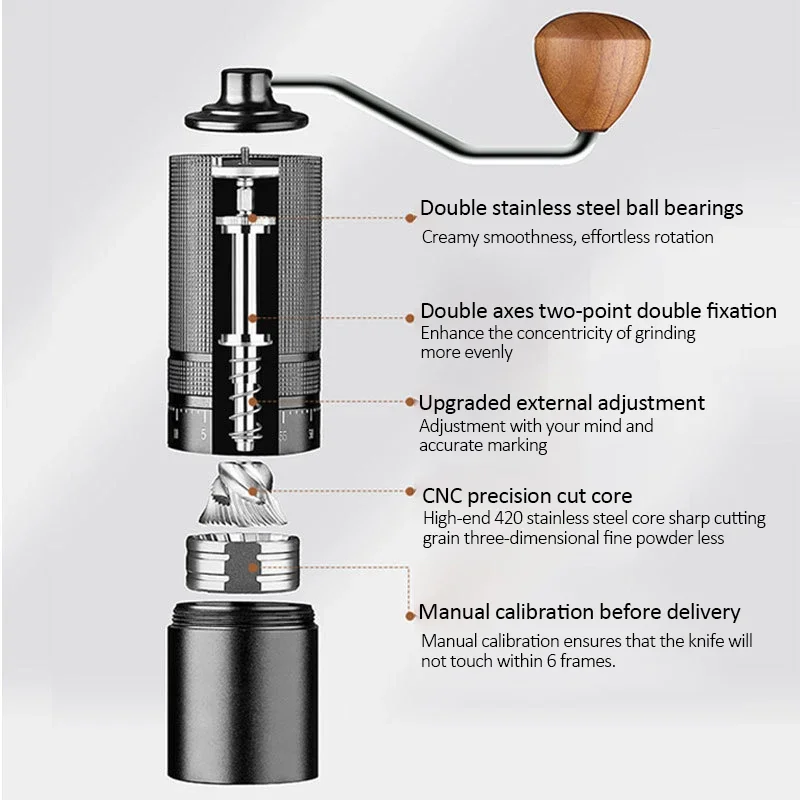
Coffee Age and Freshness:
– Fresh coffee (1-14 days off roast) contains more CO2, which can create resistance during extraction
– As coffee ages, it requires a gradually finer grind to maintain the same extraction time
– Very fresh coffee may need slightly coarser grinding with longer pre-infusion
– Aged coffee (beyond 3-4 weeks) generally needs finer grinding to compensate for reduced compounds
Roast Level:
– Darker roasts are more brittle and break into smaller particles more easily
– Lighter roasts are denser and more resistant to grinding
– Different roast levels require specific grind adjustments – typically darker roasts need slightly coarser settings than light roasts
Bean Origin and Variety:
– High-density beans (often from higher elevations) typically require finer grinding
– Softer, lower-density beans often need slightly coarser settings
– Different varieties produce different particle distributions even at identical settings
Environmental Factors:
– Higher humidity causes particles to stick together more, potentially slowing extraction
– Temperature fluctuations can affect both the grinder and the coffee’s structure
– Seasonal adjustments are often necessary as ambient conditions change
– Morning vs. afternoon conditions may require slight setting adjustments
Machine-Specific Considerations:
– Different basket depths and diameters affect optimal grind size
– Pressure profiling capabilities may allow for different grind approaches
– Heat stability of your machine influences extraction consistency
– Machines with pre-infusion often permit slightly finer grinding
These variables interact with each other, making espresso preparation a dynamic process rather than a “set and forget” activity. Developing sensitivity to these factors is part of the journey toward espresso mastery.
Advanced Techniques for Grind Perfection
Once you’ve mastered the fundamentals, these advanced techniques can help elevate your espresso quality to professional levels.
Distribution Techniques:
– Whisking Distribution Tool (WDT): Using fine needles to break up clumps and ensure even density throughout the puck
– North-South-East-West tamping: Applying gentle pressure in different directions before final tamping
– Grooming tools: Using specialized tools to create a perfectly level bed before tamping
Temperature Considerations:
– Grinder temperature affects particle size consistency
– “Seasoning” a grinder with a small amount of coffee before your actual dose can stabilize temperature
– Some professionals keep beans in climate-controlled containers to maintain consistency
Micro-Adjustments:
– For stepped grinders, you can modify dose slightly (±0.5g) to fine-tune extraction between available steps
– Tamping pressure can be subtly varied to compensate for grinder limitations
– Beans can be rested for specific periods to achieve optimal extraction characteristics
Pre-Infusion Integration:
– Lower pressure pre-infusion allows for slightly finer grinding without choking
– Extended pre-infusion can improve extraction evenness, especially with lighter roasts
– Manual pre-infusion techniques can compensate for grinder limitations
For optimal results, quality equipment makes a significant difference. Precision manual grinders designed specifically for espresso provide the fine adjustment capability necessary for these advanced techniques. Similarly, manual espresso grinders with excellent burr design facilitate consistent particle size distribution.
Remember that these advanced techniques build upon solid fundamentals. Master the basics of grind size, distribution, and tamping before attempting to implement more sophisticated approaches to extraction optimization.
Grind Consistency: Practices for Daily Success
Consistency is the hallmark of excellent espresso preparation. These practices will help you maintain reliable results day after day.
Establish a Repeatable Workflow:
– Develop a specific sequence of steps you follow every time
– Use the same movements for dosing, distribution, and tamping
– Maintain consistent timing between steps
– Document your process so it becomes muscle memory
Grinder Maintenance for Consistent Performance:
– Clean burrs regularly to remove coffee oils and particles
– Calibrate your grinder periodically to ensure settings remain accurate
– Replace burrs when they show signs of dulling (typically after 500-1500 pounds of coffee)
– Keep your grinder clean to prevent old grounds from contaminating fresh doses
Single-Dosing vs. Hopper Considerations:
– Single-dosing (grinding only what you need) minimizes waste but may affect consistency
– Hopper feeding (keeping beans in the hopper) provides more consistent pressure on the beans
– If single-dosing, consider using a weight on top of the beans to simulate hopper pressure
Managing Grind Retention:
– Purge 2-5 grams between significant setting changes to clear old grounds
– Use a small brush to clean the grinder chute between doses
– Consider “sacrificing” a small amount of coffee when dialing in to ensure freshness
Record-Keeping for Different Coffees:
– Maintain a log of optimal settings for different beans
– Note environmental conditions alongside grind settings
– Document dose, yield, time, and taste notes for each successful combination
Fine adjustment hand grinders can provide exceptional consistency for home users, often with less retention than electric alternatives. The key is finding equipment that supports your consistency goals and maintaining it properly.
Remember that consistency doesn’t mean rigidity – it means creating a reliable foundation from which you can make intentional adjustments when necessary. The goal is eliminating unintentional variables while remaining adaptable to the intentional changes in your coffee program.
Can Pre-Ground Coffee Work for Espresso?
It’s the question many beginners ask: “Can I use pre-ground coffee for espresso?” The straightforward answer is that while possible in emergencies, it significantly compromises quality.
Pre-ground coffee faces several major challenges for espresso preparation:
Rapid Degradation:
Coffee begins losing volatile compounds immediately after grinding. Within 15-30 minutes, significant flavor loss occurs. By the time pre-ground coffee reaches your home, much of its character has already disappeared.
Impossible to Adjust:
The defining feature of espresso preparation is the ability to adjust grind size to dial in extraction. With pre-ground coffee, this critical control is completely eliminated.
Inappropriate Consistency:
Even coffee labeled “espresso grind” is rarely the perfect size for your specific machine, beans, and conditions. What works in one scenario will be too fine or too coarse in another.
Emergency Workarounds:
If you absolutely must use pre-ground coffee:
– Adjust dose: Try using slightly more coffee to slow down extraction
– Modify tamping pressure: Tamp more firmly to increase resistance
– Adjust water temperature: Lower temperature can reduce over-extraction
– Manage expectations: Accept that results will be compromised
For quality espresso, investing in a manual coffee grinder for espresso is essential. These grinders offer the precision and consistency necessary for proper extraction while often being more affordable than their electric counterparts.
Fine Adjustment Hand Grinder, Precision Manual Grinder, Travel Coffee Grinder
Price range: $185.11 through $494.63 Select options This product has multiple variants. The options may be chosen on the product pageHand Burr Grinder, Hand Crank Coffee Grinder, Manual Espresso Grinder, Portable Coffee Grinder
Price range: $262.72 through $300.22 Select options This product has multiple variants. The options may be chosen on the product pageHand Burr Grinder, Manual Coffee Grinder Stainless Steel, Precision Manual Grinder
Price range: $183.64 through $187.52 Select options This product has multiple variants. The options may be chosen on the product pageManual Coffee Grinder Stainless Steel, Manual Espresso Grinder, Travel Coffee Grinder
Price range: $276.22 through $276.39 Select options This product has multiple variants. The options may be chosen on the product pageHand Crank Coffee Grinder, Manual Coffee Grinder for Espresso, Manual Coffee Grinder Stainless Steel
$349.15 Select options This product has multiple variants. The options may be chosen on the product page
In the rare emergency when you must use pre-ground coffee, focus on freshness – coffee ground an hour ago is vastly superior to coffee ground a week ago. However, for regular espresso brewing, grinding fresh is simply non-negotiable for quality results.
Is My Espresso Machine or My Grinder More Important?
When budgeting for espresso equipment, many beginners face this common dilemma: should you invest more in the espresso machine or the grinder? Industry professionals consistently provide the same answer: prioritize the grinder.
Here’s why grinder quality often proves more important than machine quality:
The Grinder’s Critical Role:
– Even the finest espresso machine cannot compensate for poorly ground coffee
– A quality grinder provides the consistency and adjustability necessary for extraction control
– Grind quality directly determines how evenly water extracts flavor from coffee
Budget Allocation Recommendations:
– For limited budgets: Invest in a quality grinder paired with a modest machine
– Common industry recommendation: Spend at least half your total budget on the grinder
– Entry-level recommendation: Better to have an excellent grinder with a basic machine than vice versa
Upgrade Path Considerations:
– A quality grinder will serve you through multiple machine upgrades
– Grinder limitations are more difficult to work around than machine limitations
– Manual grinders often provide better grind quality than electric grinders at similar price points
The espresso coffee hand grinders offered by Savor Suite represent this philosophy – providing professional-level grind quality at accessible price points. In blind taste tests, espresso made with properly ground coffee on modest equipment consistently outperforms poorly ground coffee on expensive machines.
Remember that both components matter, but if forced to prioritize, the grinder’s role in extraction quality cannot be overstated. The ability to make precise, consistent adjustments to grind size is the foundation upon which excellent espresso is built.
Fine-Tuning for Different Espresso Styles
Different espresso styles require specific grind adjustments to achieve their characteristic flavor profiles and textures.

Traditional Italian vs. Modern Specialty:
– Traditional Italian espresso typically uses darker roasts with slightly coarser grinds, creating characteristic bitterness and body
– Modern specialty espresso often uses medium to light roasts with finer grinds to highlight acidity and complexity
– Each approach requires different grind characteristics to highlight intended flavor profiles
Ristretto, Normale, and Lungo Adjustments:
– Ristretto (concentrated, 1:1 ratio): Often requires slightly finer grind to restrict flow
– Normale (standard, 1:2 ratio): The baseline for most grind setting recommendations
– Lungo (extended, 1:3 or longer): Generally needs slightly coarser grinding to prevent over-extraction during longer flow
Straight Espresso vs. Milk Drinks:
– Espresso for milk drinks often benefits from slightly finer grinding to increase body and “cut through” milk
– Straight espresso may benefit from marginally coarser grinding to highlight clarity and brightness
– Specific bean characteristics may require different approaches for optimal milk pairing
Bean-Specific Considerations:
– Single-origin espressos often require more careful grinding compared to blends
– Very light, dense beans typically need finer grinding and often benefit from higher temperatures
– Naturally processed coffees sometimes extract more readily and may need slightly coarser grinding
Finding the correct grind setting for espresso styles requires experimentation and tasting. While guidelines provide starting points, your preference for acidity, sweetness, and body will ultimately determine the perfect settings for your taste.
Remember that different styles have different extraction goals. Traditional Italian-style espresso aims for rich body and chocolatey notes, while modern specialty often highlights complex acidity and unique flavor characteristics. Neither is inherently “better” – they’re different approaches requiring specific grinding techniques.
The Journey to Espresso Mastery: Patience and Practice
Mastering espresso grind settings is not a destination but a journey – one that rewards patience, observation, and consistent practice.
Most professional baristas will tell you that developing true expertise takes months, not days. Even after years of experience, they continue refining their skills and deepening their understanding of extraction principles.
Realistic expectations for your learning curve might look like:
- First week: Understanding basic principles and recognizing major extraction flaws
- First month: Consistently producing drinkable espresso with occasional excellence
- Three months: Reliably creating good espresso with familiar beans
- Six months: Quickly adapting to new beans and changing conditions
- One year: Intuitive understanding of how to approach different coffees and conditions
Throughout this journey, focus on these milestones as signs of progress:
– Recognizing extraction issues by observation before tasting
– Predicting how grind adjustments will affect flavor
– Quickly dialing in new coffees with minimal waste
– Consistency between shots without major adjustments
– Adapting successfully to seasonal changes and different roast styles
The 30-second espresso rule provides a helpful benchmark during your learning process, but remember that timing is just one indicator of proper extraction. The ultimate goal is developing your palate to recognize balance and sweetness in the cup.
The reward for persistence is substantial – the ability to consistently create exceptional espresso that highlights the unique characteristics of each coffee bean. This skill transforms coffee from a simple beverage into a remarkable sensory experience that you can recreate and share with others.
Remember that even professionals make adjustments daily. Espresso perfection is not about finding static settings but developing the skill to adapt to the dynamic nature of coffee. With patience and practice, you’ll discover the profound satisfaction that comes from mastering the fundamental skill of espresso preparation: the perfect grind.

